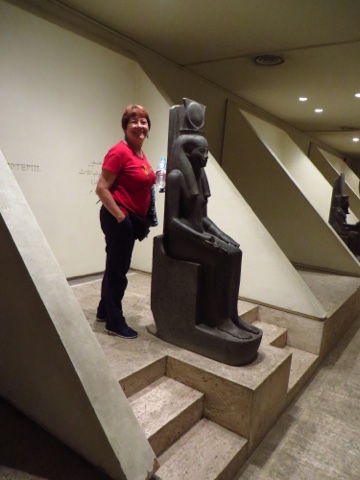March 15 - another early morning. Leaving for a long drive in the country to Dendera and Abydos. Before leaving Luxor we watched the balloons rise again over the Nile.
We took a very slow route to Dendera, stopping every 2 minutes for entrances to little towns and going over lots of serious speed bumps.
The Egyptians use all types of transportation: cars, trucks, tu-tuks, motorcycles, bicycles, donkeys.
It took an hour and a half to reach our first destination, Dendera temple. This temple was built by the Greeks to honor the Goddess Hathor, goddess of music and motherhood. Ellen is hamming it up at the entrance.
This is the statue of the God of fun, Bess.
Goddess Hathor -
The temple was built around 280 BC and it took 300 years to build. The Greeks wanted to be accepted by the Egyptians so they built this temple saying they were sons of Hathor. Hathor was always portrayed as a women with ears of a cow or with horns of a cow. Christians defaced the statues of the goddess and lite fires in the temple so the ceilings turned black with soot. Here is a partially cleaned ceiling.

The temple has a splendid hypostyle hall of beautifully carved pillars.

There are some secret passageways that our tour guide knew about. We walked down to the crypt where the treasure were kept.
This is the temple within the temple called the chapel of holiness. Here the mysteries of the birth of cosmic order from the primeval chaos were celebrated.
On the outside you can see how massive the structure is.
The only hieroglyphic of Cleopratra in Egypt (32 BC), on the back wall of Dendera.
They even had a swimming pool.
Some more camels that we did not get to ride.
Market day at a local city we passed thru on the way to our next temple.
Drove to Abydos a name given to a holy city dedicated to the cult of Osiris, the god of death.
The temple was started by Seti I and finished by his son Ramses II. These hieroglyphics below were during the rein of Ramses II. Notice that these were carved into the rock.
The hieroglyphics below are during the Seti I rule and the carvings are done so that the picture stands out. Much more difficult than Ramses.
In the back is the original temple to Osiris which the Muslims made a yearly pilgrimage to and dates back 5000 years as compared to the current temple in the front which is 3200 years old.
Traveling back to Luxor - more colorful photo opportunities.
After a long day on the road the sunset is beautiful.


































































